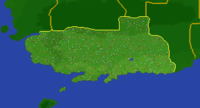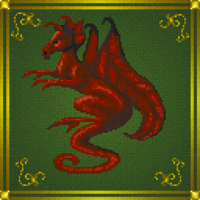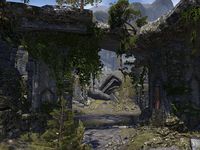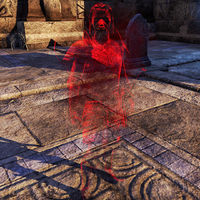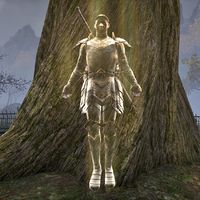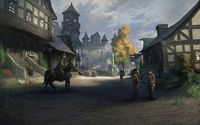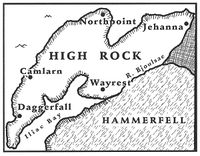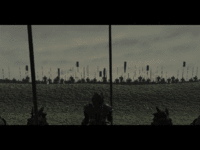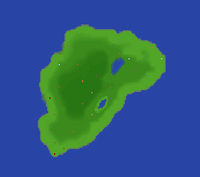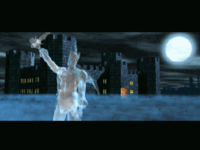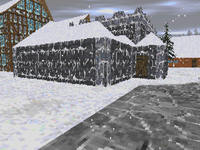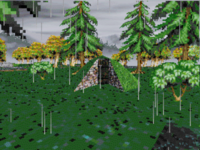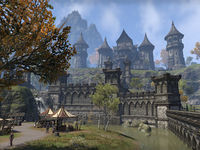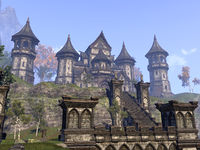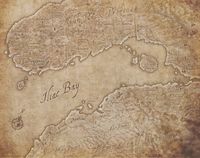Lore:Daggerfall (kingdom)
| Daggerfall | |
|---|---|
| Type | Region |
| Continent | Tamriel |
| Province | High Rock |
| Demonym(s) | Daggerfallian[UOL 1] |
| Appears in | Daggerfall |
Daggerfall is one of the nine historical Breton kingdoms in the province of High Rock,[2][3] located in the southwest portion of the province, on the north half of the Iliac Bay. Throughout much of history, Daggerfall was one of the largest kingdoms in High Rock, from the early First Era before the rise of its rival, Wayrest and its incorporation into the Third Empire,[4][5] to the turn of the Third Era, where it was one of the province's five kingdoms.[6] It is named after its capital city, Daggerfall.[4]
History[edit]
- For the history specific to the city, see the: History of Daggerfall
Early History[edit]
—Daggerfall's entry in the Book of Life, Pg. 933
While there is substantial archaeological evidence to suggest that humans have lived where Daggerfall city is now located, at least a thousand years before recorded history, the first time the name is used for a specific area was discerned around 1E 246, during the Skyrim Conquests[4] helmed by High King Vrage and the Nordic Empire.[5] One of the earliest mentions of the name in recorded history comes from a record in their census, the Book of Life. By tradition, historians perpetuate the myth that Daggerfall's name comes from the knife the first chieftain used to create the borders. The Third Era author of "A History of Daggerfall", Odiva Gallwood believes other myths have equal validity.[4]
Daggerfall was one of many fortified coastal towns built by the Nords during their occupation and its people were able to thrive on the land and the sea as fisherfolk.[4][5] However, when High King Borgas was killed in 1E 369, Skyrim was in disarray as the War of Succession pitted the holds against each other and severely weakened the Nordic Empire's hold beyond its borders.[4][7][8] The story of how High Rock was able to liberate itself from Skyrim is one established in legend and it involved the mythical heroes and companions, King Edward of Daggerfall and King Moraelyn of Ebonheart.[9]
According to legend, Edward and Moraelyn utilized an ancient artifact known as the Horn of Summoning to free High Rock and their spirits from the Nords. Most people believe that the Horn was buried with Edward in his tomb underneath Daggerfall City, but in actuality, it was laid elsewhere in Tamriel.[9] The elves of Clan Direnni played a significant part in High Rock's liberation and reigned over the region as the Direnni Hegemony.[6] In the years since the Nords' expulsion, the Kingdom of Daggerfall had only grown stronger as it greatly expanded its military.[4] At the time, it was ruled by chieftain-kings.[4][10] When Aiden Direnni invoked the Rights Charter, many Breton citizens were enlisted to fight the war against the Alessians[11] and Daggerfall served as a minor base of operations for the elves.[4]
The Battle of Glenumbra Moors, while it brought victory to the Direnni Hegemony, destitute them as they failed to stop the emergence of Greater Bretony's nobility.[5] As well as their modern-day knightly orders (chief among them included Daggerfall's Knights of the Dragon) who were able to push them back to their home on the Isle of Balfiera.[12] All of High Rock was free from elven control by 1E 500[5] and as Daggerfall continued to grow, in 1E 609, it was able to establish itself as a predominant kingdom and power in southern High Rock after King Thagore defeated Glenpoint's army. It has held onto this title ever since.[4]
King Joile and the Siege of Orsinium[edit]
For much of the tenth century in the First Era, Daggerfall was ruled by King Joile, who witnessed the original Orsinium's growth, the Orcish raiders' attack on denizens of the Bjoulsae River and the blockade on Wayrest's trade lanes.[13][14] In 1E 948, the king wrote a letter to Gaiden Shinji, leader of the Order of Diagna about his grievances to the situation.[13] Only when King Golkarr applauded these raiders did Joile decided to act and declare war on the Orcs.[15]
The Siege of Orsinium, as it is remembered in history, was a thirty-year-long conflict in which the kingdoms of Daggerfall and Sentinel united to destroy the original kingdom of Orcs.[16] The Knights of the Dragon, at the time led by Lord Trystan, worked in tandem with the Order of Diagna and the orders grew to respect each other in the process. Much to their chagrin, however, King Joile enlisted Mercedene, leader of the Winterborn mercenaries from the Reach, and gave her power over Lord Trystan.[15]
King Joile and Gaiden Shinji executed King Golkarr in Grudgement Hall, Orsinium.[17] But despite the death of the Orcish king, the siege relented and Baloth Bloodtusk reinforced the city. The Redguard gallant believed that the war had lasted longer than it otherwise should have and wanted King Joile to call it off. Lord Trystan proposed a duel between the Redguard and Baloth Bloodtusk to put an honorable end to the war. The King had other ideas in mind, however, and had General Mercedene kill both warriors in the midst of their duel. It became apparent that King Joile's reason for starting the war was not well-intention, but rather, it was a means to conquer and expand his kingdom. This act of betrayal resonated with Lord Trystan and the Knights of the Dragon, who withdrew from Joile's conquest.[15][18]
Joile and the Daggerfall Army traveled south into Hammerfell via the Bangkorai Pass in 1E 973, but their invasion was short-lived as they were confronted by six Maidens of the Spirit Sword named Cegila, Julia, Kati, Makela Leki, Patia, and Zell. In the end, only one of the six Maidens survived and Joile's army was defeated single-handedly by Makela Leki, who activated her Shehai. Joile was decapitated by the maiden and his armies scattered.[19] The Siege of Orsinium ended in 1E 980 and although Daggerfall was successful in their assault, the Orcs' downfall gave rise to their most direct competitor, Wayrest, which formally became the Kingdom of Wayrest in 1E 1100.[4][13]
Daggerfall in the First and Second Era[edit]
After Empress Hestra incorporated High Rock in 1E 1029,[21] Daggerfall's capital was able to flourish as an important settlement but much like the rest of western Tamriel, it was devastated by the Thrassian Plague,[4][5] which originally broke out in 1E 2200.[10] While the nobility of Daggerfall and other kingdoms traveled to Balfiera for refuge,[22]:6 generally speaking, the Iliac Bay's population decreased by half.[4]
It saw a further decline with the War of Righteousness between 1E 2321 and 2331,[4] the conflict that spelled the end of the Alessian Empire and came after High Rock left the Empire.[23] From a combination of the Alessians' inability to control the distant province, their disdain for the Bretons' "tainted" heritage, and their heavy taxation, Daggerfall and the other kingdoms withdrew.[24] In an unspecified event in the First Era, Daggerfall, Wayrest, and the Isle of Balfiera joined together as the League of Unrest to fight against the Cyrodiils.[25]
Starting from the early fourth century of the Second Era, the Kingdom of Daggerfall was ruled by House Deleyn,[20] who are descendants of the First Era hero, the Ivory Lord.[26] Donel Deleyn started this dynasty in 2E 342 and political marriages with nobles from Aldcroft and Northmoor strengthened the house's power.[20] Daggerfall under King Maxevian participated in the siege against the Province of Orsinium mainly orchestrated by Shornhelm.[27][28] By his order, a regiment of knights stayed behind in Watcher's Hold to prevent any Orcish incursion from coming west.[27][29]
Sometime in the sixth century of the Second Era, the kingdoms of High Rock engaged in all-out warfare with each other in the Battle of Granden Tor but in the years since experienced peace.[30] At the time, Daggerfall would have been ruled by King Bergamot,[20][31][nb 1] who also led the Knights of the Dragon in the capital city's defense against Emperor Durcorach and his Reachmen horde.[30] Upon realizing how weak their own kingdoms were and as a means to collectively unite against any foreign threat, the kings of High Rock formed an alliance known as the Daggerfall Covenant. Daggerfall was quick to propose their city as the capital but Wayrest's recent growth brought it to their favor. When the Knahaten Flu of 2E 560 passed, it claimed King Bergamot and left the throne to Folbert the Wide.[20]
With this alliance, Folbert was present with the other kings in Emeric's wedding in 2E 566[32] and later Daggerfall became instrumental in Ranser's War not long after. Despite the alliance with Wayrest, however, King Folbert believed the city's rise in prominence was a stroke of luck and that if the kingdom overextended itself, Daggerfall would come in and rise back up top. This did not come up in his lifetime, however, as he passes away.[20] An oracle of the Wyrd named Marieve was able to predict King Folbert's death[33] and by 2E 582, the throne was held by Casimir.[34] Although the kingdom remained affiliated with the Covenant, the King was adamant to make the Knights of the Dragon a separate entity from the Covenant's greater armies.[35] But when the Bloodthorn Cult invaded Glenumbra, the knightly order assisted the Covenant and the Lion Guard on their final attack in Cath Bedraud.[36]
Daggerfall and the Third Empire[edit]
The province of High Rock was fully incorporated into the Third Empire after Tiber Septim easily corralled the squabbling kingdoms[6] and employed the provisional governors to end the witch-kings' reign and feuds.[37] By the time the Tiber War was in effect across the continent, Daggerfall's capital city was considered the de-facto capital of the province, by virtue of its ancient history, prominence, and prosperity.[5] In a map of other capitals in the Empire, Daggerfall is listed among them.[38] By Cyrodilic tradition, the Kingdom of Daggerfall was able to retain its right to have a royal court.[5] When Sentinel was governed by Senecus Goddkey, nobles from Daggerfall traveled to the capital city for an exotic retreat.[39]
While it is unknown where Daggerfall sided in the war, western High Rock was entrenched in the War of the Red Diamond. The Elder Council in the Imperial City split the Imperial armies between the western army in the Iliac Bay and the eastern army in coastal Morrowind.[40] In the summer of 3E 125, King Cephorus of Gilane was able to reconquer western High Rock. Meanwhile, the death of his niece, Kintyra II around the same time sparked outrage toward Potema and Uriel III, which inspired more people to the Empire's cause.[41]
The war ended when Uriel III was defeated by Cephorus I at the Battle of Ichidag in 3E 127. By then, the kingdoms of High Rock turned toward the Empire[42] and received new levels of autonomy and independence.[43] In early 3E 266, the throne of Daggerfall was contended between Helena and her cousin, Jilathe. It was because of this the Kingdom of Daggerfall could not rally other leaders in the Iliac Bay to fight the Camoran Usurper.[44]
The History of the War of Betony[edit]
Even though the Imperial Simulacrum passed at the turn of the century, fractious wars continued to plague the continent. The Iliac Bay was the center of one such conflict, as it involved the Kingdoms of Daggerfall and Sentinel, and the small island of Betony. The island's local lord, Mogref agreed to become a vassal to King Lysandus and Queen Mynisera of Daggerfall for protection and monetary reasons.[45][46]
One person who pushed for the vassalage was the Archpriest of Kynareth, Vanech,[46] who believed Betony was the holy land of his patron. Complications arose when King Camaron of Sentinel intervened by citing a two-hundred-year-old agreement. Despite the counsel of their own respective wise women, who foresaw their deaths in the conflict, both kings pressed forward with the War of Betony in 3E 402.[45]
The war began with a sea battle on the Daggerfall Bluffs,[45] aptly named the Battle of the Bluffs.[46] Daggerfall came out victorious thanks to Lord Bridwell, general of the Daggerfall military.[45][46] In the next subsequent battles, the battle in Glenpoint's foothills and the Siege of Craghold, Daggerfall claimed victory. Over the course of the war, Lysandus' court sorceress, Medora Direnni and his mother, Nulfaga became more adamant to end the war but as enthusiastic as Lysandus was to his victory at hand, Nulfaga left the Court of Daggerfall and retired to her castle in the Wrothgarian Mountains.[45][46]
Her departure made King Lysandus reconsider the war and attempted to negotiate with King Camaron in Reich Gradkeep, with its lord, Graddock serving as a neutral mediator. The summit took place in the city's palace and was initially civil. It was decided on the Treaty of Reich Gradkeep that both kingdoms would have joint lieges of the island. This solution was never presented to the kings as Archpriest Vanech switched the treaty for another, one that would have caused offense to King Lysandus. According to legend, Lord Bridwell smashed the fake treaty with his battle axe, which created chaos in the palace. The region's capital city was in a bloodbath and both kingdoms continued their fight out in the wilderness.[45]
The Battle of Cryngaine Field and the aftermath[edit]
The generals were able to quell their armies and Daggerfall returned to their camp for the final battle. The kingdom's armies made their base in Ravennian Forest while Sentinel camped in Yeorth Burrowland, with Cryngaine Field between them. While the armies were away, Queen Mynisera discovered her husband's affair with Medora Direnni and banished her from the court. When this news reached Lysandus, he decided to leave his life as King behind so that he could spend the rest of his life in anonymity with Medora on Balfiera. He made a deal with his son, Prince Gothryd, and orchestrated a plan to fake his death. Lord Woodborne of Wayrest met with Lysandus in camp and escorted him to Tamarilyn Point while an imposter would take his place.[45]
A week later, the Battle of Cryngaine Field commenced and in the heat of battle, an unnatural fog conjured by the dragon-familiar, Skakmat enveloped the battlefield. Gothryd killed the imposter, with the narrative being that Sentinel's archers fired blindly into the fog. Gothryd, who was popular among soldiers was crowned behind the battlefront and led the army for the rest of the battle.[45] While texts on the war written by Fav'te and Vulper Newgate claim that Gothryd killed King Camaron in a confrontation,[46][47] it was Lord Bridwell who defeated him. The Sentinel army, led by Lord Oresme surrendered and Betony was fully relinquished to the Kingdom of Daggerfall in 3E 403.[45]
As part of the formal peace treaty, the newly-named King Gothryd proposed to the Princess of Sentinel, Aubk-i, and while some viewed it as a gesture toward peace and friendship, others like members of the Royal Court of Sentinel saw her as a political prisoner. Despite the measures taken for Lysandus' retirement, he was assassinated and in her grief, Medora Direnni tried to conjure his spirit. After many failed attempts and more powerful rituals, a host of undead was summoned and plagued the Isle of Balfiera.[45] Coincidentally on the 13th of Rain's Hand, known in Daggerfall as the Day of the Dead, the ghost of King Lysandus appeared in Daggerfall's capital and haunted its streets at night with his own host of ghosts in 3E 404.[45][48] King Gothryd became distrusted among his citizens and rumors circulated about how he killed his father in the Battle of Cryngaine Field.[45]
The Miracle of Peace and onward[edit]
In 3E 405, an Agent of the Blades was sent to the Kingdom of Daggerfall by the Emperor, Uriel VII to investigate King Lysandus' hauntings and to assist in a small personal manner related to the Dowager Queen, Mynisera.[49] However, a supernatural storm[50] created by Nulfaga[51] caused their ship to wreck off Daggerfall's coast and washed them ashore in Privateer's Hold, a dungeon near the Daggerfall-Tulune border. The Agent was able to escape the dungeon and embark across the Iliac Bay, where they became involved in the politics and affairs of the region.[50]
After the Blades had besieged Woodborne Hall in Wayrest, Lady Brisienna Magnessen made contact with the Agent and gave them the task of retrieving the Totem of Tiber Septim from Castle Daggerfall, believing that King Gothryd was given the totem by Lord Woodborne before the siege of his home. After the Agent took the totem, various people involved in the Iliac Bay, from the kingdoms' monarchy to the Empire made contact with the Agent in the hopes of obtaining the totem and its godly power. Gothryd was one of these individuals, however, instead of a cordial letter, the king sent his knights to take it by force but it is unknown if the Agent complied with them.[52]
In fact, what became of the Agent and the Totem is unknown to history as the Blades lost contact with them since their last encounter with Lady Brisienna. In 3E 417, a magical phenomenon known as the Miracle of Peace occurred over the Iliac Bay and changed it ever since. At the time, the kingdoms warred against each other and laid waste to the region. A three-way clash between Daggerfall, Wayrest, and Nova Orsinium took place on the 9th of Frostfall, and the land between them was destroyed as a fire started in Daenia and Ilessan Hills, and spread northeast toward Ykalon and Phrygias.[53]
The Miracle of Peace occurred on the 10th of Frostfall and once it passed, it was suddenly the 11th of Frostfall. The forty-four nations in the Iliac Bay became four Imperial counties; the previous kingdoms, which had expanded and encroached on these smaller countries. Daggerfall took over much of the western Bretonic-Iliac Bay region, from as far as Ykalon and western Anticlere and now shared its border with Wayrest. Peace had been achieved, and not just across the Iliac Bay[53] but the entire province. High Rock encompassed five major kingdoms[6] and the newly formal province of Orsinium.[16] Daggerfall in the late years of the Third Era only prospered as King Gothryd and Queen Aubk-i had their first child, Camaron. At the turn of the era, they celebrated his marriage with Lady Kelmena of Camlorn, which suggested a possible alliance with the kingdom.[6]
Culture and Society[edit]
Although the Bretons are unsentimental to their past, Daggerfall is of considerable antiquity[5] and its people are obsessed with its past. The kingdom keeps an ancient record known as the Annals of Daggerfall, and with it has documented and preserved many things, including King Joile's original letter to Gaiden Shinji from 1E 948.[13]
The Bretons of Daggerfall celebrate holidays annually, some of which are recognized across the continent or province. But some are only observed in the kingdom, such as Dancing Day on the 23rd of Midyear. Everyone from the nobility to the lower class celebrates this day with merriment and festivities. It is unknown who started this tradition but it was popularized by the Red Prince, Atryck in the Second Era.[54]
The Day of the Dead, held on the 13th of Rain's Hand, however, has a darker tone as the people believe in a superstition that the dead would rise on this day and wreak havoc across the kingdom.[48] The holiday harkens back to Bretonic religion in antiquity and despite its modern meaning, suggests ancestral worship, which defined the religion at the time.[55] Interestingly, this was the day that King Lysandus returned from the grave after his death in the War of Betony.[48] As a country within the Glenumbra region, the people of Daggerfall once observed the Day of Release on the 8th of Sun's Dawn. To remember the Battle of Glenumbra Moors, a battle where Aiden Direnni was able to banish the Alessian Order from High Rock. By the Interregnum, this holiday was recognized across Glenumbra[56] but by the late Third Era, only the Barony of Glenumbra Moors remembers this battle and continues the holiday tradition.[57]
Of all the Divines, the Goddess of the Winds and the Seas,[58] Kynareth is held in the highest regard across the Kingdom of Daggerfall. Not only is her temple, the Temple of Kynareth prevalent across the region, from Gothway Garden to Penbrugh and Singmoth,[59] she is recognized as the goddess-protector of the region. Even the island under their protection in the late Third Era, Betony was holy land associated with Kynareth.[45] The kingdom's heraldry features a four-legged dragon,[60] a mythical creature that went nigh extinct after the Dragon War of the late Merethic Era.[61] Daggerfall's association with the creature can be seen with its local knightly order, the Knights of the Dragon. Even the sovereign of Daggerfall refers to themselves as the Dragon.[62][63] A piece of treasure in Daggerfall is the Daggerfall Champion's Chestplate, a heavy armor cuirass.[64][65]
Beyond the cities' walls are a variety of other races and subcultures that live in the kingdom. Barbarians live in keeps like the Hold of Copperham and Ashfield Tower and many Giant strongholds are scattered throughout the region, such as Druigod, Tricergon, and Yagrugoth.[66] Harpies also live in the region and beyond just the cliffs outside of the city, the Shrieking Scar,[67] there are harpy nests like the Aviary of Morarock and the Nest of Vojgon.[66] The Sisters of the Bluff is a witches coven that operates in the region, specifically in the Daggerfall Bluffs and south of the Burning Martyr of Kynareth.[68] The Vraseth clan of vampires is the dominant bloodline in the region,[69] with ancestry that leads directly to the original vampire, Lamae Beolfag.[70] There are many different vampire haunts across the region, such as the Haunt of Magnoghan and Castle Vladimyth.[66]
Geography[edit]
Daggerfall is a coastal region on the western edge of High Rock, right on the Iliac Bay and the Eltheric Ocean.[59] Geographically speaking, the kingdom's capital city is located on the tip of Glenumbra, more specifically the Daenia region,[71] not to be confused with the Third Era duchy of the same name. Much of the coast is known as the Daggerfall Bluffs[4][45][68] but on the south-central part of the coastline are two unnamed peninsulas. Between these peninsulas is a bay and the biggest city within this area is the capital of Daggerfall itself.[59]
Many cities dot the region, from the western and southern coast, to the northern and eastern borders. These included Aldingwall, Baelmoth, Burgwall, Charing, Charening, Charton, Chesterwark, Cromwych Hill, Deerbridge Hollow, Gallotale, Grimfort, Holham, Ipshead, Kirkcart Wood, Knightstown, Longtown, Longtry Field, Mercester, Midbury, Newcester, Oxway, Penbrugh, Reyford, Ripmarket, Singcroft, Singmoth, Stokworth, Tunbeth Hamlet, Uptower Moor, Westhead Moor, Whitewood Borough, and Wildertown.[59]
In 3E 405, the Kingdom of Daggerfall was neighbored by several other regions, including Glenpoint to the north, Ilessan Hills to the north-northeast, Shalgora to the east, and Tulune to the northwest.[72] The border with Tulune is defined by an inlet.[59] After the Miracle of Peace settled and redefined the Iliac Bay, Daggerfall's borders expanded and absorbed its neighbors, to the point it now bordered the newly-expanded Kingdom of Wayrest. The kingdom's new border went as far north as Ykalon and as far east as western Anticlere.[53]
Notable city-states and regions that are part of the Kingdom of Daggerfall are:
Notable Locations[edit]
- Castle Necromoghan
- An underground dungeon near the border toward Ilessan Hills. It was owned by the Dowager Queen Mynisera as a getaway from the capital city
- Daggerfall
- The capital city of the region, generally located on the southern coast of the kingdom
- Daggerfall Bluffs
- The kingdom's coastal region. It is the site of a battle in the War of Betony and the home of the Sisters of the Bluffs
- Privateer's Hold
- A dungeon in the northwest corner of Daggerfall near Tulune. An Agent of the Blades landed here after a terrible storm
- Unnamed Island
- An island located southwest of the capital city, between the mainland and Betony. The largest settlement is Penwold on the west coast
Known Rulers[edit]
The Kingship of Daggerfall is sometimes known as the Dragon of Daggerfall,[63][73] or simply the Dragon.[62] Although the various dynasties go by their own names, such as the Deleyn Dynasty,[20] the current family that rules the kingdom are collectively known as the House of Daggerfall.[22]:15
In the kingdom's early years, it was ruled by chieftain-kings.[4][10] In service to the monarch is the aptly named Court of Daggerfall,[59] also called the High Court of Daggerfall.[74] A tradition of the Iliac Bay is that the Archpriest of the region's main temple serves the court and in this case, the Archpriest of Kynareth works under the King.[45][75] Unlike most other nations, where there can only be one Dowager Queen, the Kingdom of Daggerfall is an exception to this rule as both Nulfaga, wife of King Arslan II, and Mynisera, wife of King Lysandus held this title at the same time.[2]
Early in the city's history, the kings of Daggerfall lived in a fortress now known as Daggerfall Overlook, which is located southeast of the city.[76] Now they live in Castle Daggerfall, which is found in the highest point of the city and overlooks the surrounding area and sea.[77]
- Unknown Dynasty
- Unnamed Chieftain of Daggerfall — As myth dictates, this chieftain was the first ruler of Daggerfall and the one who threw the knife that marked its borders.[4]
- Clan Direnni
- Raven Direnni (between 1E 369 and 1E 609)[4]
- Unknown (around 1E 470)[78] — The source gives that Clan Direnni controlled Daggerfall in 1E 470, yet no specific name is given for its ruler. It is entirely possible that it refers to Raven. Nevertheless, the approximate reigns of Raven and the anonymous Direnni are listed here separately for completion's sake.
- Edward's Dynasty
- King Gerald (before Corcyr's reign)[79]
- King Corcyr I (before Edward's reign)[80]
- King Edward (unclear precisely) — "King Edward, Part I" says he was active some time "before the Redguards came [...] but after the goblins had driven the dwarves out of Hammerfell", which would place him between 1E 700 and 1E 808.
- Unknown Dynasty
- Deleyn Dynasty[20]
- King Donel Deleyn (2E 342 – 2E 401)[20]
- King Anton I (2E 401 – 2E 450)[20][81]
- King Maxevian (fl. 2E 434 – 2E 458)[27][29] — Maxevian is only mentioned in two documents and contradicts every other source for the monarchs of the Deleyn Dynasty of that time.
- Queen Donella (2E 450 – 2E ?)[20][81]
- King Anton II (2E ? – 2E 515)[20]
- King Bergamot (2E 515 – 2E 560)[20]
- King Folbert the Wide (2E 560 – 2E ?)[20]
- King Casimir (ca. 2E 582)[20]
- Mortyn's Dynasty
- Lysandus' Dynasty
Gallery[edit]
Notes[edit]
See Also[edit]
- For game-specific information, see the Daggerfall article.
Books[edit]
- A History of Daggerfall by Odiva Gallwood — A relatively unbiased analysis of Daggerfall and the Iliac Bay
References[edit]
- ^ Pitof's dialogue in ESO
- ^ a b Etiquette With Rulers — Erystera Ligen
- ^ Map of High Rock – The Elder Scrolls: Arena
- ^ a b c d e f g h i j k l m n o p q r s A History of Daggerfall — Odiva Gallwood
- ^ a b c d e f g h i Pocket Guide to the Empire, 1st Edition: High Rock — Imperial Geographical Society, 2E 864
- ^ a b c d e Pocket Guide to the Empire, 3rd Edition: The Sons and Daughter of the Direnni West: High Rock — Imperial Geographical Society, 3E 432
- ^ Pocket Guide to the Empire, 1st Edition: Skyrim — Imperial Geographical Society, 2E 864
- ^ Olaf and the Dragon — Adonato Leotelli
- ^ a b The Real Barenziah, v 4 — Anonymous
- ^ a b c Pocket Guide to the Empire, 1st Edition: The Wild Regions — Imperial Geographical Society, 2E 864
- ^ A Life of Strife and Struggle — King Laloriaran Dynar
- ^ The Knightly Orders of High Rock — Lady Cinnabar of Taneth
- ^ a b c d Wayrest, Jewel of the Bay — Sathyr Longleat
- ^ Antique Map of Stormhaven antiquity codex entries in ESO: Greymoor
- ^ a b c Lord Trystan's dialogue in ESO: Orsinium
- ^ a b Pocket Guide to the Empire, 3rd Edition: Orsinium — Imperial Geographical Society, 3E 432
- ^ The Great Siege of Orsinium
- ^ The Ashes of Our Fathers quest in ESO: Orsinium
- ^ a b From The Memory Stone of Makela Leki — Makela Leki
- ^ a b c d e f g h i j k l m n o The Improved Emperor's Guide to Tamriel: High Rock — Flaccus Terentius, 2E 581
- ^ Bangkorai, Shield of High Rock — King Eamond
- ^ a b c d The Daggerfall Chronicles — Ronald Wartow
- ^ Systres History: Volume 4 — Trilam Heladren, Associate Dean of Eltheric History, University of Gwylim
- ^ On the War of Righteousness — Valenca Arvina, Historian-in-Residence at Gwylim University
- ^ Maiko K'Elmar's dialogue in Redguard
- ^ The Ivory Lord: A Hero Born
- ^ a b c King Maxevian's Orders — King Maxevian
- ^ The Fury of King Ranser — Wafimeles Masteret (Lorekeeper)
- ^ a b Letter to King Maxevian — Captain Orrent Retene
- ^ a b Triumphs of a Monarch, Ch. 3 — His Majesty King Emeric
- ^ a b Shornhelm, Crown City of the North — Lord Wylon, 39th Baron Montclair
- ^ a b Triumphs of a Monarch, Ch. 6 — His Majesty King Emeric
- ^ Vanus Galerion's dialogue in ESO
- ^ King Casimir in ESO
- ^ Chamberlain Croix's dialogue in ESO
- ^ Mists of Corruption story quest in ESO
- ^ Krisandra's dialogue in Redguard
- ^ Map of Tamriel – Provinces of Tamriel
- ^ Pocket Guide to the Empire, 1st Edition: Hammerfell — Imperial Geographical Society, 2E 864
- ^ Brief History of the Empire, v 1 — Stronach k'Thojj III
- ^ The Wolf Queen, v7 — Waughin Jarth
- ^ Brief History of the Empire, v 2 — Stronach k'Thojj III
- ^ The Wolf Queen, v8 — Waughin Jarth
- ^ The Fall of the Usurper — Palaux Illthre
- ^ a b c d e f g h i j k l m n o p The Daggerfall Chronicles/Narrative
- ^ a b c d e f The War of Betony — Vulper Newgate, 3E 404
- ^ The War of Betony — Fav'te
- ^ a b c Day of the Dead holiday description in Daggerfall
- ^ Introduction in Daggerfall
- ^ a b Privateer's Hold story quest in Daggerfall
- ^ Employer's dialogue during the "Background Information" quest in Daggerfall
- ^ Totem, Totem, Who Fets the Totem? story quest in Daggerfall
- ^ a b c The Warp in the West — Ulvius Tero
- ^ Dancing Day holiday description in Daggerfall
- ^ Holidays of the Iliac Bay — Theth-i
- ^ Day of Release Roisterer costume description in ESO
- ^ Day of Release holiday description in Daggerfall
- ^ Light-Keeper Menoit's dialogue in ESO: High Isle
- ^ a b c d e f g Daggerfall region in Daggerfall
- ^ Banner of Daggerfall – The Elder Scrolls II: Daggerfall
- ^ The Dragon War — Torhal Bjorik
- ^ a b Knights of the Dragon
- ^ a b Daggerfall ending description in Daggerfall
- ^ Daggerfall Champion's Breastplate of the Wyrd Tree in ESO
- ^ Sir Lanis Shaldon's dialogue in ESO
- ^ a b c Daggerfall dungeons in Daggerfall
- ^ Shrieking Scar in ESO
- ^ a b The Sisters of The Bluff in Daggerfall
- ^ Vraseth faction in Daggerfall
- ^ Vraseth NPC in ESO
- ^ Daggerfall in ESO
- ^ Labeled Map of the Iliac Bay – The Elder Scrolls II: Daggerfall
- ^ Daggerfall CES Cinematic
- ^ Words and Philosophy
- ^ Chil'a holiday description in Daggerfall
- ^ Daggerfall Overlook loading screen text in ESO
- ^ Daggerfall Castle loading screen text in ESO
- ^ Elven Artifacts vIII — Ith-Mok
- ^ King Edward, Part IV — Anonymous
- ^ King Edward, Part I — Anonymous
- ^ a b Journal of Magiul Shiana — Magiul Shiana
- ^ a b The Wolf Queen, v1 — Waughin Jarth
- ^ Daggerfall location and rumors in Arena
Note: The following references are considered to be unofficial sources. They are included to round off this article and may not be authoritative or conclusive.
- ^ Ted Peterson's Posts in Campaign 7/The Evening Star Parade – Loranna's RP
- ^ a b Xanathar's Library Archive/History
|
|||||
